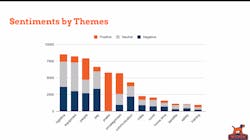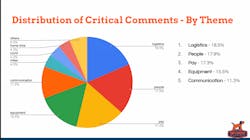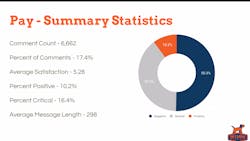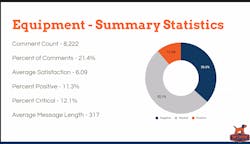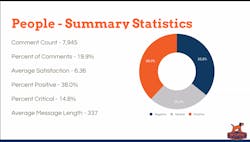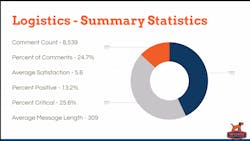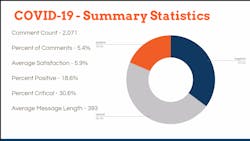Essential workers such as truck drivers had no option to work from home last year when many other workers could leave offices as the COVID-19 pandemic upended lives across the country. To help give fleets a better understanding of how drivers felt and worked during 2020, WorkHound kept in constant contact with thousands of drivers to see how they were navigating a year unlike any other.
On a 10-point scale, WorkHound-surveyed truck drivers rated their job satisfaction with an average 6.39 score. “This is higher than anticipated considering the variety of challenges the industry faces this year,” Max Farrell, the CEO and co-founder of WorkHound said during a conference call hosted by Stifel on Jan. 25. He later noted that overall, there were more positive comments from drivers in 2020 than in WorkHound’s 2019 surveys.
WorkHound was able to get feedback from almost 12,000 drivers in 2020. Those drivers work for fleets with 60 to 2,000 trucks, hauling a mix of dry van, reefer, tanker, intermodal, flatbed, and expedited freight. More than three-quarters of those surveyed are company drivers and 23% are owner-operators or independent contractors. The feedback is anonymous and surveys are conducted by text messages every week.
Logistics was the most common topic in drivers’ feedback, Farrell said. This was joined by people, pay, equipment, and COVID-19 as the Top 5 themes on drivers’ minds during 2020. “While communication as a theme didn't make the Top 5, it is a dominant feature among the comments within the top themes, highlighting the importance of clear and concise communication with drivers,” he added.
More than 4,000 (about 11%) of the 38,500 comments drivers shared with WorkHound were critical of carriers. “Nearly 2,500 unique drivers left these comments,” Farrell said. “While the average comment length was 214 characters, critical comments were 359 characters on average — meaning the drivers are offering a lot of detail when frustrated. Dissatisfied drivers will often take more time to provide the information companies need to retain them by sharing lengthier comments.”
Farrell said that while equipment is frequently commented on, drivers are not as critical of their equipment as they are of their paychecks and the people they work for or with.
About 80% of all comments from drivers are about people, which was the third-most mentioned topic in 2020, according to Paul Castronova, WorkHound’s strategic projects manager. “With about 38% of comments being positive, commenters within the people theme frequently shout-out others,” he explained. “Companies we work with are maximizing the impact of this positivity by distributing the shout-outs through other internal channels. When comments in the people theme are negative, this is likely due to interpersonal or departmental conflict.”
While it might be expected that the relationship between fleet managers and drivers would be contentious, Castronova said that is not typical in WorkHound’s surveys. “It’s actually pretty positive,” he said, before adding: “However, it is important to remember that one bad interaction between a driver and a manager can cause drivers to quickly express a desire to leave.”
While all comments from drivers are initially anonymous, WorkHound can facilitate a conversation between drivers and managers after negative comments. “The anonymity really encourages drivers to be more honest with their feedback, eliminating problems that probably wouldn't have gotten surfaced in the first place,” Castronova said.
After a negative comment, if a carrier wants to address the issue, WorkHound can ask the driver to reveal his or her identity so the problem can be addressed directly.
Here is a look at some of the main themes WorkHound found through its 2020 surveys:
Pay
If there was any theme in comments about pay, it was confusion. Castronova said that 41% of the comments about pay came in the form of questions. While one would assume comments about pay would be full of complaints, he said that isn’t the case.
“The abundance of questions in the feedback indicates that commenters are seeking clarification about complex pay policies and structures,” Castronova said. “It’s not simply an opportunity to vent frustrations.”
He said that simplifying and stabilizing pay structures can go a long way to building trust and minimizing confusion, adding that if drivers are reliant on bonuses to reach their financial goals, it “is a strong indicator that pay rates are too low. If too many drivers at the company are in this scenario, it's important to take some time to make certain that pay is aligned with market rates or carriers risk losing a lot of good drivers.”
Equipment
The second most common theme of driver feedback in 2020 was about equipment. “When drivers have feedback to share about equipment, it tends to be urgent and likely something is broken, or drivers haven't been properly trained regarding how something works,” Farrell said.
He said that 20% of equipment feedback is about maintenance — often complaints about the fleet’s shop not fixing a reported issue or requiring more than one trip to the shop for the same problem. Other complaints are about slow repair times or understaffed maintenance staff, which drivers say can limit their uptime and reduce their pay.
Farrell recommends that fleets establish transparent, easy-to-communicate processes to align expectations and invest in regular training for technicians.
People
Comments about people drivers work with made up 19.9% of responses in 2020. On average, most drivers rated people at 6.36 on a 10-point scale; 38% of the nearly 8,000 comments about people were positive, while 14.8% were critical.
Farrell said that listening could go a long way in fostering a positive relationship with drivers. “We know the world has changed drastically in the past year,” he said. “If I've learned anything, it's that we're all struggling with something. We're not going to be 100% every day and the past year has taught us how important it is to be more empathetic. And listening to our people is a great place to start. While communication challenges were a common thread throughout all the themes in the feedback we saw, it's clear more than ever that when we listen and understand where drivers are coming from, act quickly and tell them what we did.”
Logistics
Comments about logistics include feedback related to operations, load planning, delays and route challenges. “Logistics appeared most frequently in 2020,” Farrell said. “While logistics covers a broad range of topics, oftentimes these concerns are urgent because drivers may consider seeking employment outside the industry.”
Only 13% of logistics comments were positive in 2020. Farrell noted that drivers sharing feedback on logistics often happen “in the heat of the moment and typically, this feedback covers multiple things like communication and pay. So, when logistics comes up, often is perception versus reality of whether or not something is true.”
WorkHound suggests logistics issues can be improved with transparency. Fleet managers who keep drivers in the loop when making changes can go a long way, Farrell said. He also suggested that managers set realistic expectations with current drivers and during the hiring process.
COVID-19
WorkHound started getting COVID-19 feedback from drivers in February 2020. “Our team started documenting this feedback as it came in,” Farrell said. “What wound up happening is that it led to carriers tightening up the communication process and becoming innovative in how they kept drivers in the loop with the ever-changing information around vaccines, or PPE, or new regulations rules.”
While COVID-19 made up a smaller percentage of comments last year, they were highly critical comments, never dropping below 27% after peaking at a 38% negative rate. Farrell said drivers are looking for more empathy from their employers while working on the pandemic’s front lines.
“For example, during these times, we often saw most of the concern about potentially getting a loved one sick or feeling unsupported by the possibility of getting sick,” Farrell said. “We're nearly a year into the pandemic, but it's never too late to improve how we navigate it. So we certainly recommend the companies are proactive in their communications around things like testing, quarantine requirements, and vaccinations and letting drivers know that you have their back and will support their intentions to do the responsible thing such as providing masks and enforcing the same rules for the whole staff, not just drivers.”
About the Author
Josh Fisher
Editor-in-Chief
Editor-in-Chief Josh Fisher has been with FleetOwner since 2017. He covers everything from modern fleet management to operational efficiency, artificial intelligence, autonomous trucking, alternative fuels and powertrains, regulations, and emerging transportation technology. Based in Maryland, he writes the Lane Shift Ahead column about the changing North American transportation landscape.

